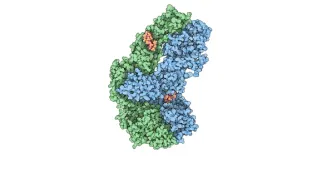
Physical activity itself is beneficial, but combining it with an appropriate diet - high in protein, with carbohydrates, with a low glycaemic index - gives the best results in regulating body weight and balancing metabolic disorders in patients with obesity, researchers from the University of Physical Education in Kraków have shown.
What training and which diet are the most effective?
Previous research by the team led by Agnieszka Suder, PhD, a professor at the University of Physical Education in Kraków, and Karol Makiel, PhD, from the Department of Anatomy of the University of Physical Education in Kraków and colleagues, has shown that the most effective way to reduce body weight in a healthy way in obese people - with a large loss of adipose tissue, but without losing muscle mass - is strength and aerobic training. Unlike aerobic exercise alone, performed at a high heart rate, it led to the body re-composition, which translated into an improvement in the metabolic state of the entire body and stabilization of the level of adipokines - hormonal substances secreted by adipose tissue.
In their latest study described in Scientific Reports (https://doi.org/10.1038/s41598-024-79853-7),the same scientists checked whether combining the aforementioned training with an appropriate diet would bring even better results in improving the health of obese patients.
The project lasted six weeks. It involved 44 adult men with a BMI above 30 and a waist circumference exceeding 94 cm. The participants were divided into three groups: those performing only strength and aerobic training without a diet; a combined group, which, in addition to training, followed the recommended diet, and a control group, which did not implement any interventions.
'As for the diet, it was high-protein with carbohydrates with a low glycaemic index (GI). However, it is very important that it was not an elimination diet, excluding specific nutrients. Our participants were simply asked to increase the share of protein from the initial intake of 17 to about 25 percent by choosing recommended products, and ensure that the carbohydrates consumed had a low glycaemic index. The participants themselves chose the products they wanted to eat. We only provided them with a list of suggested dishes. I emphasise this because thanks to this, i.e. mainly qualitative changes, the participants unknowingly generated a negative energy balance leading to weight loss', Makiel says in an interview with PAP.
The list included lean poultry meat, low-fat dairy products, lean fish, legumes, whole grain cereals, vegetables and fruit.
'We wanted the patients to not only lose weight, but also improve their metabolic health at the same time. Since they were to do strength training, they needed the right amounts of protein and energy from carbohydrates. In addition, protein and carbohydrates, which gradually release glucose into the blood, rich in fibre, provide a long-lasting feeling of satiety and greater satisfaction from eating, and consequently - lead to eating smaller portions', the researcher explains.
'We also took the psychological aspect into account, the so-called restraint theory, according to which the more restrictively someone wants to maintain a diet, through calorie control, etc., the more often they lose control over it, e.g. on weekends, or abandon this way of eating and return to old habits', he adds.
Loss of fat tissue without muscle loss
After six weeks, a statistical analysis of the obtained results was carried out. It confirmed the greatest health benefits in the group of people using the diet and training intervention, far beyond simple weight loss.
'Over the course of six weeks, participants in the diet and training intervention lost an average of 4 kg of body weight. But the most important thing was that they lost primarily adipose tissue (14 percent), especially visceral adipose tissue (31 percent). The latter is particularly important because it is abdominal obesity that is associated with a higher risk of developing metabolic syndrome, type 2 diabetes, cardiovascular diseases and chronic inflammation', Agnieszka Suder summarises the results.
The group using training alone also showed an improvement in body composition, but these changes were much smaller than in people who, in addition to exercise, also introduced changes to their diet. Importantly, the muscle mass of the participants remained intact, which distinguishes the investigated interventions from many traditional weight loss strategies, where muscle loss usually occurs.
One kilogram of white adipose tissue burns about 6 kcal per day. For comparison: one kilogram of active muscle tissue uses up to 100 kcal per day. 'Please note that a 2 kg muscle mass increase can increase daily energy expenditure by up to 200 kcal. This is the equivalent of the energy burned during a half-hour jog by a person weighing 70 kg', Makiel emphasises.
The control group, subjected only to health education, did not demonstrate any significant changes in the analysed parameters.
Weight loss and improved metabolic health
'The combination of both forms of intervention, i.e. strength and aerobic training with diet, brought 4-6 times better results than training alone in the same period. In the combined group, we also observed the most beneficial changes in terms of metabolism', the researcher says.
The most important effect in this regard was a decrease in total cholesterol by 11 percent, and LDL cholesterol by 14 percent. Makiel explains that this result is comparable to the effects of drugs, e.g. statins.
Another extremely important result in the combined group was the regulation of the concentration of adipose tissue hormones, responsible, among other things, for regulating hunger and satiety. For example, the concentration of asprosin, an adipokine discovered in 2016, responsible for the feeling of hunger, dropped by 16 percent, and leptin, a protein that in normal conditions generates a feeling of satiety, by 48 percent, which - as Agnieszka Suder emphasises - is a favourable result.
'This is important because in people with obesity, leptin resistance occurs, where the body stops responding properly to leptin signals, and the decrease in the concentration of this hormone can contribute to the improvement of the sensitivity of leptin receptors, as well as the reduction of inflammation, which has a beneficial effect on metabolic health', she explains.
Volunteers for a study wanted
Together with specialists from the Pomeranian Medical University and the Jagiellonian University, the same team of scientists has undertaken another project. This time, it will also involve combining aerobic and strength training, but in a slightly different form.
The researchers are looking for 100 volunteers - people with obesity (BMI above 30 and waist circumference above 94 cm), who will maintain a diet for three months and perform specially designed training three times a week.
'We plan to start the study in mid-March, so those interested can contact us now. Thanks to the collaboration of many specialists, the study will be very comprehensive; we will analyse not only the concentration of adipose tissue hormones and inflammatory markers, but i addition specialists from the Pomeranian Medical University and the Jagiellonian University will conduct a DNA methylation analysis, thanks to which we will be able to assess the impact of the training and diet intervention on epigenetic age and metabolic health', Agnieszka Suder announces. (PAP)
PAP - Science in Poland, Katarzyna Czechowicz
kap/ zan/













